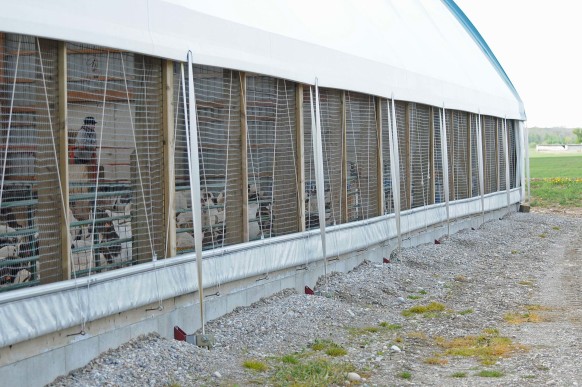Things to consider when expanding your goat facilities

Click here for a PDF of this issue of The Goat Gazette.
Ontario’s goat industry is in expansion mode. Many meat and dairy goat producers are looking at building new facilities or renovating existing buildings to grow their businesses.
Construction or renovation is an ideal time to ensure your farm is following the best management practices that have been developed for dairy and meat goat production.
It’s also an opportunity to consider making changes that can either strengthen your biosecurity to help keep disease out or improve the welfare of your animals – or perhaps even both.
Here are some things to consider as you embark on your herd expansion project.
Barn buildings, shelters, and fences
- Buildings should be large enough to house your herd at maximum production, allow for regular cleaning and maintenance, and keep wildlife, rodents, and unauthorized people out.
- Proper natural or mechanical ventilation will reduce respiratory disease risks, control humidity, ammonia levels and drafts, and ensure goat comfort.
- Natural and supplemental lighting will help you better observe and manage your herd.
- Goat barns should have:
- hospital pens for sick animals
- kidding pens
- working pen with a chute or squeeze to hold onto individual animals
- separate area to quarantine or isolate new goats coming into the herd
- pens that allow you to separate groups of goats and provide room for exercise.
- Pasture areas should include shelters to protect goats from sun, rain and wind; fences should be stable enough to contain goats in a specific area and reduce predator access.
- Specific to meat goats:
- A building with dedicated pens for breeding, maternity and early kid care is needed.
- Build a weaning pen and dry doe pen for separating kids from their dams, and a breeding pen to house bucks and does together during breeding.
- During kidding season ensure adequate penning is available to construct temporary pens for does with kids to encourage bonding, ensure access to feed and water is available.
- Specific to dairy goats:
- Indoor facilities are needed for breeding, birthing, kid segregation and acclimatizing doelings to the herd.
- Milking parlour and milk tank must be in place that meets the herd’s peak production capacity and is compliant with the Milk Act. All milking and storage equipment must be able to be cleaned and sanitized after each use.
- Good light intensity will help increase milk production.
Feed and water
- Storage areas need to suit the feed types and amounts you’re using in your operation, including bunks or silos for haylage/silage, well‐draining areas for balage, covered storage for dry hay and straw bales, and an enclosed storage area(s) for pelleted feed and Keep all feed storage areas dry, and secure from pests, rodents, and livestock.
- Size and position your feeders, troughs and bunks so that kids and goats have easy feed access, and ensure they’re high enough to minimize manure and urine contamination.
- Keep your feed distribution equipment, such as bale handlers, bucket loaders, skid‐steers, feed carts, and TMR mixers dedicated to distributing feed to pastures, pens and shelters, and ensure it can be cleaned and disinfected effectively.
- Make sure you have watering equipment that can deliver clean drinking water to various locations around your farm and that water troughs and bowls are easily accessible to goats and kids. These should be cleaned regularly.
- Specific to dairy goats:
- Provide a continuous supply of warm, clean water to lactating does and have additional waterers for does to access right after milking.
Physical maintenance
- Ensure your facility is well-designed with materials that are strong and long-lasting, and surfaces that are resistant to damage and normal wear and tear.
- Avoid or eliminate sharp or protruding objects that could harm the goats, and keep an eye out for any excessive chewing by goats on facility parts or equipment.
- Regular maintenance of your buildings and equipment – including fences, pens, milk house, feeding equipment, water systems, ventilation and heating systems, and manure management – will help keep your farm operable and your production stable.
Visitors, pests, and biosecurity
- Familiarize yourself with biosecurity practices for Canadian goat farms regarding visitors.
- Post a sign at your farm entry identifying it as a biosecurity zone and require visitors to report to your farm office when they arrive.
- Provide a clearly marked parking area away from your goat facilities for visitors.
- Use fences, gates, and locks to keep animals and people out of your goat facilities to avoid disease transmission.
- Set up an anteroom or other space at the entrance of your production area for any visitors to change into clean, farm-specific footwear, gloves and/or coveralls before entering further.
- Add a strip of gravel, asphalt or concrete up to one metre wide around the exterior of your barn to keep pests and rodents from getting in.
- Install permanent screens on your window, fan and vent openings to keep insects, birds, cats, and rodents out – but be careful not to use screens with holes that are too small or you will restrict air flow.
- Use only covered garbage bins in the barn and remove your trash regularly.
